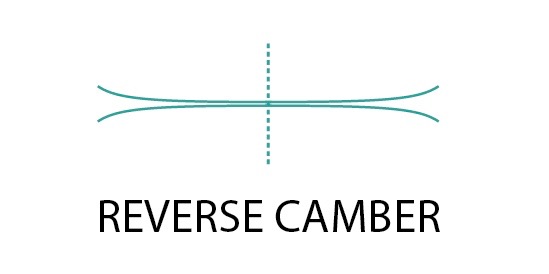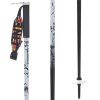 The most commonly used ski shape — found on everything from kids’ skis to slalom, freestyle, professional, and recreational models. This construction offers the best edge grip, making it ideal for hard-packed slopes or groomed snowparks. When you place the skis base-to-base, the tips and tails touch, while there’s a small gap under the bindings.
The most commonly used ski shape — found on everything from kids’ skis to slalom, freestyle, professional, and recreational models. This construction offers the best edge grip, making it ideal for hard-packed slopes or groomed snowparks. When you place the skis base-to-base, the tips and tails touch, while there’s a small gap under the bindings.
[kembr]
 The complete opposite of traditional camber. This shape has very little edge grip on groomed slopes, but it excels in deep, soft powder. Reverse Camber skis “surf” on top of the snow, while classic Camber skis tend to sink in. When you place the skis together, the bases touch in the center (under the bindings), while the tips and tails lift apart.
The complete opposite of traditional camber. This shape has very little edge grip on groomed slopes, but it excels in deep, soft powder. Reverse Camber skis “surf” on top of the snow, while classic Camber skis tend to sink in. When you place the skis together, the bases touch in the center (under the bindings), while the tips and tails lift apart.
[revers kembr]
 A super popular ski shape in recent years. Compared to the traditional Camber, the difference is at the tip — the contact point of the base is shifted closer to the center, and from there, the tip gradually rises upward. The main advantage of a Nose Rocker is easier handling in mixed or rough snow conditions, and it also works great off-piste. We recommend this shape especially for beginners.
A super popular ski shape in recent years. Compared to the traditional Camber, the difference is at the tip — the contact point of the base is shifted closer to the center, and from there, the tip gradually rises upward. The main advantage of a Nose Rocker is easier handling in mixed or rough snow conditions, and it also works great off-piste. We recommend this shape especially for beginners.
[nous rokr]
 Similar to the Nose Rocker, but here both the tip and tail gradually rise. This makes it easier to ride switch (backward) and to handle deep snow. The ski’s midsection still has a classic camber, which means it maintains good edge grip even on hard slopes. Sometimes also referred to as Nose and Tail Rocker.
Similar to the Nose Rocker, but here both the tip and tail gradually rise. This makes it easier to ride switch (backward) and to handle deep snow. The ski’s midsection still has a classic camber, which means it maintains good edge grip even on hard slopes. Sometimes also referred to as Nose and Tail Rocker.
[typ end tejl rokr]














